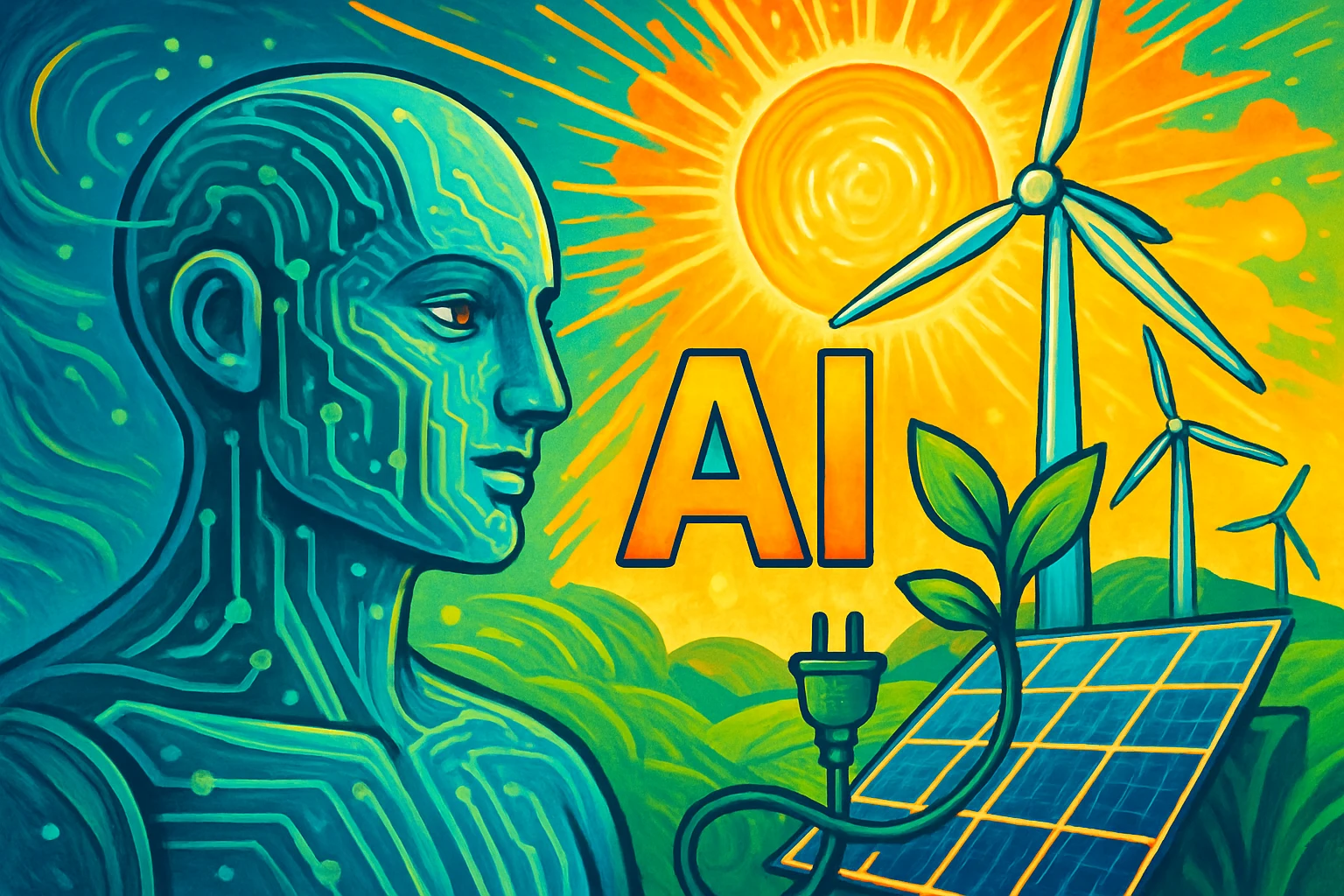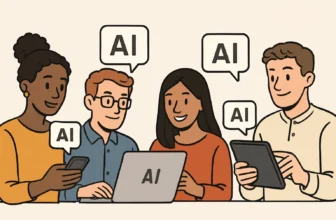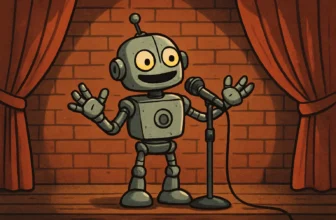
AI Meets Green Energy: A Perfect Match?
Did you know that over 30% of renewable energy generated globally gets wasted because we don’t always know when or how to use it efficiently? Yep, solar panels keep soaking up sun, even when demand drops. Wind turbines spin like pros during low-usage hours. And all that green energy? It just hangs out… unused.
I know, it sounds frustrating. All that potential—gone with the wind (literally). But here’s the good news: artificial intelligence (AI) is stepping in like the ultimate energy manager we didn’t know we needed.
Now, I’ll be real with you—before I started learning about sustainability technology, I kinda thought AI was just for things like chatbots or those creepy-smart TikTok filters. But once I saw how AI is quietly transforming how we produce, distribute, and consume renewable energy? Let’s just say I got seriously geeked out. If we want clean energy to be more than just a buzzword, we need systems that can keep up—and that’s where AI shines.
So what’s the problem?
Renewable energy is unpredictable. The sun doesn’t always shine. The wind doesn’t always blow. Yet, we still need electricity 24/7. That mismatch between energy production and demand is a major headache for grid managers. And storing energy? It’s still expensive and complex.
But AI? It thrives on uncertainty. While humans struggle to connect the dots, algorithms crunch massive data like weather patterns, user behavior, and supply peaks to make split-second decisions that are smarter than anything our current systems can handle.
Where AI steps in like a boss
- Forecasting the future—accurately: AI can predict weather trends with scary precision to prepare the grid for what’s coming. More sun tomorrow morning? Dial up the solar. Storm rolling in? Shift reliance elsewhere.
- Smart grid management: AI-powered smart grids learn energy usage habits and adapt in real time, balancing supply and demand like a digital tightrope walker.
- Boosting efficiency: AI helps wind turbines self-adjust for optimal performance and recognizes when panels are underperforming—even before humans detect a thing.
For example, Google used an AI from DeepMind to boost its wind farm energy predictions by nearly 20%. That’s like giving wind power a crystal ball. Imagine the scale if more providers got on board.
What we can do (yep, even us non-coders)
- Support smart tech initiatives: Look for energy providers using AI to manage renewables or advocate for climate-focused innovation funding.
- Upgrade your own habits: Use smart thermostats and energy-efficient devices that sync with broader AI-powered grids.
- Stay curious: The more we understand the intersection of AI and green energy, the more power (pun intended) we have to push for sustainable change.
At its heart, AI renewable energy isn’t about replacing humans. It’s about enhancing our efforts to build a cleaner, smarter world. And we’re just scratching the surface.
So, is AI and green energy a perfect match? Well, maybe not perfect—but it’s definitely the power couple our planet’s been waiting for.
The Challenge: Unpredictability in Renewables
Did you know that the sun could be shining brightly one minute and be blocked by clouds the next—causing solar output to drop by 80% almost instantly? Seriously. That’s the energy equivalent of a mood swing.
And if you’ve ever tried relying on solar panels or wind turbines, you know exactly what I’m talking about. One gust of wind, one shift in the weather, and suddenly the whole system goes haywire. It’s like trying to plan a picnic during hurricane season—frustrating and totally unpredictable.
This is the double-edged sword of renewable energy: it’s clean, safe, and well, renewable… but it’s also unreliable. And when cities or even entire countries want to move away from fossil fuels, that unpredictability becomes a serious headache. We can’t have our hospitals, transportation systems, or heck—even our coffee makers going down every time the sun takes a nap, right?
So, How Do We Fix That? Say Hello to AI
Enter our techy superhero: Artificial Intelligence. And nope, this isn’t the scary kind from sci-fi movies. We’re talking smart algorithms quietly working their magic in the background to reduce chaos and boost stability.
Here’s how AI tackles the unpredictability of renewables:
- Weather Forecasting, But Smarter: Traditional forecasts might tell you it’ll rain tomorrow. AI forecasting tells you exactly how much less solar energy you’ll produce in your area by 2:13 PM. Seriously precise stuff. I once volunteered for a community solar project, and we used an AI-powered dashboard to schedule energy usage—and managed to slash reliance on the grid by 25% in a month. Real-time predictions? Game-changer.
- Balancing the Grid: When supply drops suddenly (like when a cloud moves overhead), AI can shift demand automatically—think adjusting battery storage levels, rerouting electricity, or even triggering backups for high-priority zones. It’s like having an eagle-eyed conductor making sure the whole orchestra (aka your energy system) plays in tune, even if a few instruments go rogue.
- Learning as It Goes: The best part? These systems learn. That means each new storm, gust of wind, or sunnier-than-expected afternoon fine-tunes them for even better performance next time. So the longer we use AI, the more reliable our renewable energy becomes.
Hope on the Horizon
So, yes—renewables have their moody moments, but with AI in the mix, we’re getting better at dancing in sync with nature’s rhythms. No more second-guessing if the wind will blow or the sun will shine. With AI forecasting and adaptability, we’re turning unpredictability from a problem into an opportunity.
Here’s the takeaway: Renewable energy isn’t broken—it just needed a brainy sidekick. And AI fits the bill perfectly. The future? It’s not just green; it’s smart, too. 🌱⚡
Smart Grids: The Backbone of AI Integration
Did you know that power outages in the U.S. have increased by more than 60% over the past decade? Yep, despite all our modern tech, the grid we rely on is still kind of… outdated. That stat blew my mind too. And it got me thinking — if we’re moving toward a clean, AI-powered energy future, how the heck are we going to get there with a clunky 20th-century power system?
That’s where smart grids come in. If renewable energy is the heart of sustainability, then smart grids are the nervous system. They’re what allow all the pieces — solar panels, wind turbines, EV chargers, battery banks, and homes like yours and mine — to work *together*, in real time, with precision. No more guesswork about energy demand. No more wasting power because it can’t get to where it’s needed. It’s honestly kind of magical.
What Exactly *Is* a Smart Grid?
Think of a smart grid as your regular ol’ power grid, but with a tech upgrade. Instead of a one-directional, push-it-and-pray kind of system, it’s interactive. Powered by AI, it can actually think for itself in some ways — analyzing data, predicting usage spikes, adjusting supply, and even rerouting electricity if there’s a problem.
Let me paint a quick picture: Imagine you’re cooking dinner, it’s hot as heck, and everyone in the neighborhood has their AC blasting. A traditional grid might struggle, leading to brownouts. But a smart grid? It sees the surge coming, balances the load by tapping into stored energy or adjusting non-essential usage, and keeps your lights on and your AC humming. No drama. Just smart power.
How AI Supercharges the Grid
AI is the real MVP here. It sifts through mountains of real-time data — weather forecasts, energy usage patterns, even traffic data (because yes, EVs matter!) — to make quick, super-informed decisions. Here’s how that plays out:
- Predictive maintenance: AI can detect and fix problems in the grid before they cause a blackout. It’s like having a mechanic for the grid that never sleeps.
- Efficient distribution: It ensures renewable energy (which, let’s be honest, can be intermittent) is stored and dispersed intelligently where and when it’s actually needed.
- Consumer energy management: Some smart grids allow homeowners to track and adjust their own energy use through apps, which is *so* empowering — especially if you’re someone who loves a good data dashboard like I do.
Real-World Successes (And They’re Kinda Inspiring)
Let’s take Spain, for example. Iberdrola’s smart grid rollout saved over 30% in energy loss — *30%!*. And in California, Pacific Gas and Electric uses AI-driven systems to prevent wildfires by predicting which parts of the grid are at risk and shutting them down preemptively. That’s tech literally saving lives and the environment at the same time. Warms your heart a bit, right?
So, What Can We Actually Do?
Glad you asked! Here’s how we can support this shift in real life:
- Upgrade to smart meters at home: These help households use energy more efficiently and give you insights into your energy habits.
- Advocate for local smart grid investment: Join public meetings, support policy changes — your voice matters more than you think.
- Support energy companies using AI tools: When choosing providers or investing, lean into the ones with tech-powered, eco-conscious plans.
The Bottom Line
Here’s the truth: Going green isn’t just about solar panels and wind turbines (although we LOVE those). Without smart grids and AI integrating it all, renewable energy can’t reach its full potential. But with them? The future is smarter, cleaner, and way more efficient.
I don’t know about you, but I find that *wildly* exciting. We’re not just dreaming of a sustainable future — we’re literally engineering it. And that’s something to plug into. ⚡
Enhancing Energy Storage Capabilities
Did you know that in some regions, up to 30% of renewable energy is wasted simply because we can’t store it efficiently? Ouch, right? That stat hit me like a rogue wind turbine blade. We’re generating all this clean, green power — limitless sunshine, gusty winds — and still letting a chunk of it slip through our fingers like sand. Why? Because storage is still kinda stuck in the past.
Here’s the deal: renewable energy isn’t constant. The sun doesn’t always shine (looking at you, three straight days of clouds), and the wind? She’s a moody one. That’s where energy storage comes in. It’s like the pantry for your clean energy — you want to stock up when there’s plenty so you’re not left in the dark later.
But the battery tech? It’s got some catching up to do. Traditional systems don’t always know the best times to charge or discharge, especially when renewables are unpredictable. Plus, managing lots of power sources across a grid? Crazy complex. That’s why reliable, intelligent energy storage is such a big deal. And guess who just rolled in with a genius solution dressed in ones and zeroes? Yup. AI.
So, How’s AI Helping Us Store Power Smarter?
Here’s where it gets cool—like, sci-fi level cool. AI, particularly machine learning and even fancy things like neural networks, is now being used to supercharge the way we manage and store energy. I recently read about a smart battery management system that basically “thinks” like a brain. It learns daily usage patterns, predicts energy supply dips and surges, and makes super smart decisions on when to save, when to store, and when to let the power flow. I mean, how futuristic is that?
Here are a few AI-driven innovations making waves in energy storage:
- Neural Network Battery Management Systems (BMS): These systems use deep learning to continuously monitor battery health and optimize charge/discharge cycles. Less waste, longer battery life—win-win!
- Predictive Analytics for Grid Storage: AI algorithms forecast when energy demand will spike or drop, helping storage systems prep in advance. Think of it like meal prepping, but for electricity.
- Swarm Intelligence in Microgrids: AI helps small, decentralized energy networks ‘cooperate’ and share storage efficiently—kind of like bees working together in a hive… only with solar panels instead of honey.
I’ve actually seen one of these systems in action at a local solar co-op. They installed an AI-enhanced battery setup after struggling to keep power consistent on cloudy days. Six months later? Energy waste dropped by 22%. And neighbors literally got excited when their phone apps lit up with predictions of peak sunshine. Talk about feeling empowered.
What Can We Do Moving Forward?
If you’re into activism, tech, or just love the planet (I see you!), this is an area worth diving into. Here are some action steps:
- Support policies and initiatives that fund smart grid and AI-integrated energy research.
- Invest in or advocate for AI-based home battery systems if you’re going solar at home. Ask your installer what’s available — there are more options than ever.
- Stay informed. Follow how AI is changing the energy game so you can share the excitement (and the facts) with your community.
Bottom line? We’re on the edge of something huge. With AI and renewable energy teaming up, energy storage is no longer the weak link — it’s becoming the superhero cape that helps us power through cloudy days and still come out shining. The future’s not just green…it’s smart, too.
AI: Making Energy Consumption Smarter
Did you know: Nearly 60% of all energy produced globally ends up being wasted due to inefficiencies in how we use it? Yikes. That’s enough power to light up entire continents — going straight down the drain.
It’s kind of wild when you think about it. We’re pouring tons of effort (and money) into creating clean, renewable energy — solar panels, wind farms, hydro systems — and yet we’re still leaking energy like a sieve on the usage side. That’s where AI steps in like a savvy energy coach, helping both your cozy little smart home and big, humming industrial plants clean up their act.
The Problem: Energy Use Is Often Blind and Wasteful
We all do it. You leave the lights on in the kitchen while binging Netflix in the living room. Heating the whole house when you just need your bedroom warm. Or those businesses keeping machines humming full power when they’re only running at 50% capacity. There’s no villain here—just a lack of visibility and control.
I remember realizing my smart thermostat had this “eco mode” I wasn’t using. One small setting change later, I saw my electricity bill dip. I felt like a genius—until I realized AI had basically done the thinking for me.
That’s really the magic of AI: It watches, learns, and optimizes without us needing a PhD in energy systems. It’s the silent genius in the background saying, “Hey, we can do better.”
Solutions: Let AI Do the Heavy Lifting
Curious how you can invite AI onto your energy team? Here are a few smart, actionable ways:
- Smart Home Devices: Invest in AI-powered thermostats (like Nest or Ecobee), lighting systems, and appliances. These gadgets learn your habits and tweak usage without compromising comfort. Think cooler bedrooms at night, warmer mornings… all without lifting a finger.
- Home Energy Monitoring: Platforms like Sense or Emporia track where your energy goes. AI helps identify vampire energy drains (yes, that phone charger still sipping juice) and suggests usage schedules. You’ll be surprised how much you can save.
- AI for Businesses: If you’re running operations, explore AI platforms that enable predictive maintenance or dynamic energy optimization. Companies like GridPoint or BrainBox AI help industrial buildings use less without hurting productivity – kind of like a super-efficient operations manager with a green cape.
In every one of these examples, AI is basically reducing energy use not by saying “use less,” but by saying “use it smarter.”
The Payoff: A Leaner, Greener Energy Future
Here’s the beautiful thing: Smarter energy usage doesn’t just cut your electric bill (though, hey, that part is sweet). It reduces demand pressure on the grid, shrinks your carbon footprint, and, multiplied across homes and industries, it paves the way for a far more sustainable world.
And the best part? You don’t have to micromanage a million switches. The AI does the thinking for you, constantly tweaking things in the background, fine-tuning efficiency like a digital maestro.
The future isn’t just about producing energy cleanly — it’s about consuming it intelligently. And with AI, we’re finally getting that chance. Let’s plug into that future together.
AI and Renewables: A New Dawn
Did you know that AI could reduce global greenhouse gas emissions by up to 4% by 2030? That’s equivalent to taking every car off the road in Japan—and then some. Wild, right?
When I first read that stat, I had to take a moment. Like, who knew smart algorithms could have such a huge impact on climate change? It’s not some futuristic fantasy anymore; artificial intelligence is already reshaping the way we create, store, and use renewable energy. And honestly, that gives me a real sense of hope. Because let’s face it—the news can get overwhelming. The melting ice caps, the power outages, the rising temps… it’s easy to feel powerless.
But here’s the thing: we’re not powerless. Far from it.
From Curiosity to Contribution
Maybe you’re a coder who’s been tinkering with machine learning. Or maybe you’ve just installed solar panels and want the data behind them to work smarter. Wherever you land on the tech-to-green spectrum, there is a place for you in this exciting new eco-tech era.
- Learn and Leverage: Dive into AI tools being used in the green space—think tools like Google’s DeepMind that help reduce energy use in data centers by 40%.
- Get Involved Locally: Join community renewable co-ops or projects that incorporate smart grids and real-time energy use data. Many use open-source AI so it’s easy to contribute.
- Support Ethical Innovation: Not every AI initiative is created equal. Follow and fund startups that aim for sustainability, equity, and clean tech. Your voice (and wallet) matters.
I have a friend named Sam—total AI geek, and now working at a startup that uses machine learning to predict wind patterns for turbines. A few years ago? He was just reading Reddit threads on climate tech. Today? He’s actively helping power thousands of homes more efficiently. It’s amazing what can happen when curiosity meets purpose.
The Big Picture
So here we are, standing on the edge of something huge. AI and renewable energy aren’t just solving individual problems—they’re reshaping entire systems. Cleaner air. Smarter grids. Empowered communities. Imagine a world where your electric car charges itself during the sunniest hours because your rooftop solar system worked with AI to plan it all out. That’s not just the future. It’s already happening in small pockets—and growing fast.
Here’s the real question: What role will you play?
Whether you’re building tech, investing in clean energy, or simply spreading the word, every step matters. This isn’t just about innovation—this is about protecting what we love: our planet, our future generations, and yes, even our sanity during those rolling blackouts. 😅
Let’s nurture our planet together—starting today. The smart, sustainable world we dream about? We’re the ones who can build it. And AI? That’s just the rocket fuel. Ready to jump in?












